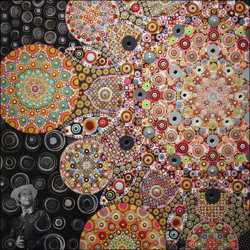Optimistic American Discords
dal 18/3/2010 al 15/4/2010
Segnalato da
Jon Barwick
Roni Feldman
Elizabeth Ferry
Ryan Peter Miller
Grant Vetter
Casey Vogt
Edward Lucie-Smith
Roni Feldman
18/3/2010
Optimistic American Discords
Werkstattgalerie, Berlin
On display works by Jon Barwick, Roni Feldman, Elizabeth Ferry, Ryan Peter Miller, Grant Vetter, Casey Vogt. The six young American artists in this show have formed a group that they have named 'Cacophonic'. Forming groups is, of course, the traditional way in which young artists band together in order to get a hearing. Curated by Edward Lucie-Smith and Roni Feldman.

curated by Edward Lucie-Smith and Roni Feldman
Jon Barwick, Roni Feldman, Elizabeth Ferry, Ryan Peter Miller, Grant Vetter, Casey Vogt
The six young American artists in this show have formed a group that they have named
'Cacophonic'. Forming groups is, of course, the traditional way in which young
artists band together in order to get a hearing. Think, for example, of the
Futurists at the start of the 20th century and of the Surrealists who followed them.
Roni Feldman, a member of the group and my co-curator, says that their work is a
reaction to a decade that began with planes crashing into the World Trade Center in
New York, and ended with an equally resounding economic crash - a period of
"complexity and dissonance, marked by a clamorous rise in technology, especially the
technology of information, as well as by wars and other forms of disaster." He and
his colleagues engage with a world of conflicting values, in the visual arts as well
as in politics, and welcome the uproar that results. "We are wary of didacticism."
He says, "and recognize that a work of art is, first and foremost, a unique sensory
experience. The balance between content and physical presence in our work reflects
an enduring optimism in the face of the odds that we believe is typical of our
generation of American artists."
Jon Barwick constructs mixed-media paintings that acknowledge the hyper-paced,
technologydriven, media-saturated society of the Twenty-First Century. The
multi-layered compositions reflect the complexities of the information age, and
capture the singular moment of everything happening at once. Imagery for these works
originate as drawings and doodles but are scanned, photographed, printed, or redrawn
before reaching the final composition. By maintaining a dialogue between the
hand-drawn and computer-generated, Barwick creates visual metaphors for our
day-today interaction with technology. The resultant fields of color and imagery are
at once beautiful andoverwhelming. They present a sublimation of information. Roni
Feldman applies the blurred, ethereal nature of airbrushed acrylic to paint
multitudinous human features. He forms tensions between individual and crowd,
abstraction and representation.
Using varying degrees of matte and gloss black paint, the imagery may be invisible
at first glance, but as viewers pass before them, the figures refract revealing an
elaborate composition. In them, whirls of figures celebrate, mourn, protest,
consume, dance, and embrace alongside others that drown, burn, and dissolve.
Feldman's crowds evoke the power and ecstasy of unified intention alongside a
potential descent into mob mentality. The compositions recall the idealistic pursuit
of 1960's psychedelia, van murals, and other airbrush art forms, but in Feldman's
work, airbrushed paint is like a thin veil that separates utopia and dystopia,
civilization and chaos.
Elizabeth Ferry blurs the edges between the corporeal and ethereal. Ranging from
simple grids to elaborate stacks of folded fabric, Ferry composes color and form
into rhythms that perpetually, illusionistically reconfigure themselves. Through
carefully cued light and site sensitivity, they shift from mundane materials to
enigmatically charged visual sensations. For example, at first glance Ferry's grids
appear as formal white structures set upon a wall painted with bright colors.
However, a move from side to side reveals that the edges of the structure are
painted with discordant dashes of fluorescent hues that refract upon the wall.
Subverting the fast pace of everyday transactions between people, places, and
information, Ferry applies abstraction and illusion to offer moments of sensitive
reflection.
Ryan Peter Miller uses paint as both his material and subject. Each of Miller's
works expresses an inventive application of paint. In one work, he applies paint as
multitudinous stacked units in a tower. In another work he casts acrylic paint as
puzzle pieces. In a third piece, Miller casts a full body self portrait in white
acrylic paint. For Miller, paint is raw material, loaded with turgid historical
significance, that can be grouped and restructured into non-traditional supports.
Miller calls painting a democratic process, reflective and responsive to history and
culture, but with endless potential for evolution and re-contextualization.
Grant Vetter's Rendition paintings are slathered with sinewy gobs of fleshy hues.
The works effect the transcendent painterliness of Abstract Expressionism, but also
the corporeal gore and almost forensic examination of mutilated skin. The word
"rendition" implies a subjective experience or recollection, but is also defined as
"deportation for war crimes" and "torture by proxy." Although Abstract expressionism
was often seen as a symbol of democratic freedom and individual expression, Vetter
explicitly takes up the themes of trauma, subjection and oppression as it relates to
the current War on Terror.
Casey Vogt creates ornate, mandala-like compositions that serve as a backdrop for
politicallycharged figurative scenes. The most recent figures explore Americans'
relationships to drug use, the War On Drugs, and the pharmaceutical industry. The
backgrounds are composed of masses of layered dots and myriad colors, recalling a
pharmacopoeia of pills.. They act as a painterly and metaphysical contrast to the
socio-political narratives presented by the figures. With their euphoric colors and
psychedelic compositions, Vogt's work proposes painting as another mind-altering
substance.
Berlin Collective presents Artist Talks moderated by Marc Glöde and Sophie Eliot
Sunday 21st March 2010 at 5 pm
Image: Casey Vogt, Against the Grain,house paint, collage on panel, 61cm x 61cm, 2009
Opening Reception: Friday 19th March 2010 at 8 pm
Werkstattgalerie
Eisenacher Str. 6, 10777 Berlin
Open: Tu-Fr 12-8 pm, Sa 12-6pm
free admission



